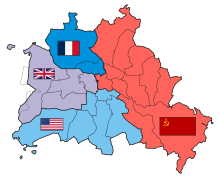Great Glienicke
The town Groß Glienicke is administratively separated for the 1945th The western part was a municipality in the Soviet occupation zone and the GDR . In 2003 it became part of Potsdam . The eastern section came to West Berlin district of Spandau and there is a local situation in the district Kladow . Both parts of the place kept the original name; the one on the Berlin side, however, in the different spelling "Groß-Glienicke" (with hyphen).
The Potsdam district has around 5,000 inhabitants on an area of 10.25 km², the somewhat smaller Berlin part a good 3,000 inhabitants.
geography
Groß Glienicke is located in the north of Potsdam and in the south-west of Berlin. The place borders clockwise on the following places or Berlin districts: Dallgow-Döberitz , Berlin-Staaken , Berlin-Wilhelmstadt , Berlin-Gatow , Berlin-Kladow, Berlin-Wannsee , Potsdam and Wustermark .
To the north of Groß Glienicke lies a large forest area, the Döberitzer Heide . Within the village lies the Groß Glienicker See , which the Berlin - Brandenburg border runs through. The Sacrower See lies south of the village . Other bodies of water are the Teufelsgraben, the Kleiner See in the nature reserve Kleiner See and the Fischpfuhl.
history
Groß Glienicke in Havelland was first mentioned in a document in 1267. The place name was derived from the Slavic term for clay and clay glina . The village church, a plastered stone building, was built in the 13th / 14th centuries. Century. The pulpit , altarpiece , patronage stalls and other furnishings in the church date from around 1680. The church contains epitaphs and tombstones of the former lords of the von Ribbeck family , who resided here from 1572 to 1788. At the beginning of the 20th century , the Otto Wollank family had historicizing buildings and a hereditary burial erected in the former park of the manor . The manor was abandoned after the death of the last owner, the couple Otto and Dorothea Wollank because of its debt burden in 1938, the mansion burned in 1945 from. Administratively, the rural community initially belonged to the Havelländisches Kreis and from 1817 to the district or later district of Osthavelland within the administrative district of Potsdam in the province of Brandenburg. In 1910 there were 248 inhabitants in the 6.7 km² community. When in 1920 the neighboring Kladow was included as part of the Spandau district in the formation of Greater Berlin , Gross Glienicke became the neighboring municipality of the capital; In view of the distance of over 20 km to the city center of Berlin, the ties with Potsdam and Spandau dominate to this day. In 1939 the population had grown to 2271.
An exchange of territory between the Soviet occupation zone and the British Sector of Berlin (see also Staaken ) resulted in the municipality area coming to the West Berlin district of Spandau from the middle of the Groß Glienicker See in 1945 and now, as a locality, Groß-Glienicke belongs to the district of Kladow. The Brandenburg part continued to exist as an independent community Groß Glienicke (spelling without hyphen) and was incorporated into Potsdam on October 26, 2003.
The estate park and its facilities were severely damaged by the course of the inner-German border . The Berlin Wall separated the the GDR - district of Potsdam associated community from Groß Glienicker See from. The lake was a popular leisure destination for West Berliners, and the citizens on the other side of the Wall were unable to see it. Only the street name Seepromenade reminded them of living in the immediate vicinity of a large swimming and recreational body of water. The border ran in the middle of the lake, so there were occasional border incidents.
traffic
The federal highway 2 and the highway 20 to Seeburg -Dallgow-Döberitz- Falkensee run through Groß Glienicke .
The next motorway junction is on federal road 273 (Potsdam-Nord) or on federal road 5 (Berlin-Spandau). Both lead to the federal highway 10 .
Several bus routes run through the village, including night bus routes. Line 638 is ideal for connecting the districts in Brandenburg and Berlin. The forest settlement in the north of the village is connected by bus 639, a shuttle service between the forest settlement and the town center.
Attractions
Sights in Groß Glienicke are:
- Village church
- Manor park
- Memorial plaque of the division of Germany on the border with Berlin-Spandau
- Rest of the Berlin Wall in the Gutspark
- the Alexander House
literature
- Georg Dehio et al. : Handbook of German Art Monuments . Districts Berlin / GDR and Potsdam , Akademie-Verlag, Berlin 1988.
-
Thomas Harding : The House by the Lake: A Story of Germany . Heinemann, London 2015.
- German: summer house by the lake. Five families and 100 years of German history . Translated from the English by Daniel Bussenius. dtv, Munich 2016. ISBN 978-3-423-28069-3 .
- Theodor Fontane : Walks through the Mark Brandenburg . Volume 3 ( Havelland ) "Potsdam and the surrounding area" - Groß Glienicke
Web links
- Groß Glienicke Castle in the 19th century (Duncker Collection) (PDF; 245 kB)
- Groß Glienicke at potsdam.de
- Andreas Kalesse: The Groß Glienicke manor park
- gross-glienicke.de
- Groß Glienicke in the RBB program Landschleicher on October 16, 2005
Individual evidence
- ↑ Great Glienicke
- ↑ Population: Inhabitants by district in 2015 . As of December 31, 2015. potsdam.de
- ↑ Changes in the municipalities in Germany, see 2003. StBA
- ↑ The Groß Glienicke estate park
Coordinates: 52 ° 28 ' N , 13 ° 6' E



